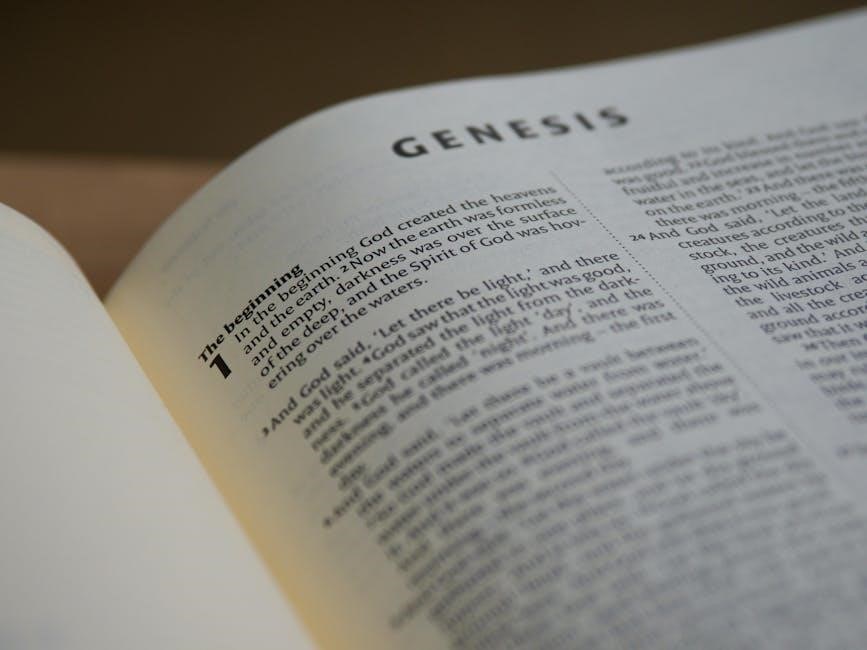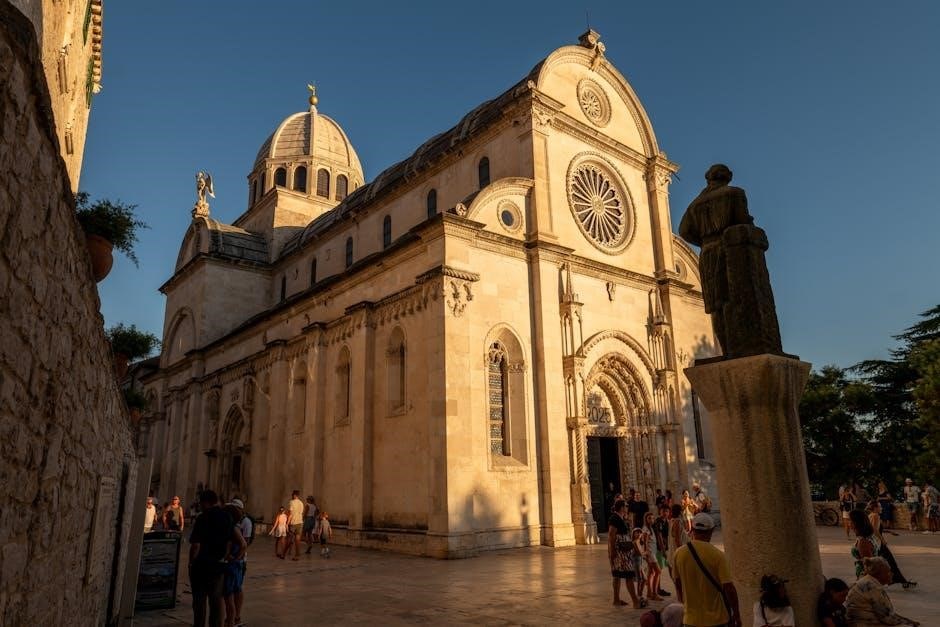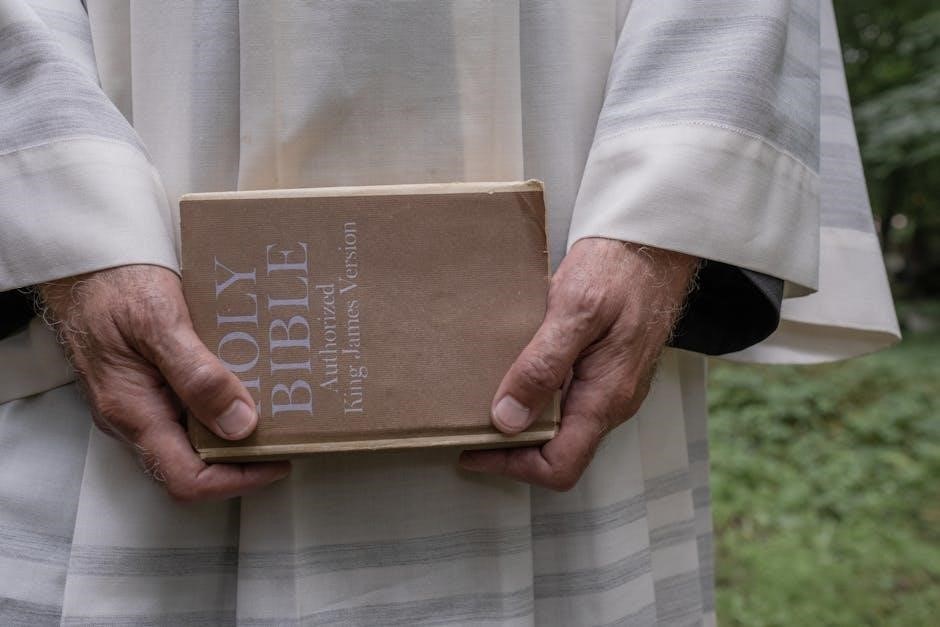The Protoevangelium of James is a significant early Christian text, offering an infancy narrative focused on the life of Mary, the mother of Jesus. Composed in the second century, it provides detailed accounts of Mary’s birth, upbringing, and marriage to Joseph, filling gaps left by the canonical Gospels. This non-canonical text has profoundly influenced Christian tradition and Marian devotion, with its themes and narratives widely disseminated across various cultures and languages. Its availability in PDF formats has made it accessible for modern scholars and readers, ensuring its continued relevance in theological and historical studies.
1.1. Definition and Overview
The Protoevangelium of James, also known as the Protevangelium Jacobi, is an early Christian apocryphal text that narrates the life of Mary, the mother of Jesus, from her conception to her marriage with Joseph. This infancy gospel is not part of the canonical Bible but is significant for its detailed account of Mary’s upbringing in the Temple, her miraculous birth, and her role as the mother of Jesus. Composed in the 2nd century, it is one of the earliest and most influential non-canonical texts, providing insights into early Christian theology and Marian devotion. Its narratives have shaped cultural and religious traditions, making it a vital text for understanding early Christian thought.
1.2. Historical Significance
The Protoevangelium of James holds profound historical significance as one of the earliest apocryphal texts detailing the life of Mary and the infancy of Jesus. Composed in the 2nd century, it bridges gaps in the canonical Gospels, offering narratives about Mary’s divine conception, her Temple upbringing, and her marriage to Joseph. This text has deeply influenced Christian doctrine, particularly Marian theology, shaping devotion to Mary as the Virgin Mother. Its widespread dissemination across cultures highlights its role in early Christian thought and its enduring impact on religious and cultural traditions, making it a cornerstone of early Christian literature.
1.3. Purpose and Audience
The Protoevangelium of James was written to fill narrative gaps in the canonical Gospels, particularly regarding Mary’s life and the infancy of Jesus. Its purpose was to provide a theological foundation for Marian devotion and to satisfy early Christian curiosity about the Holy Family. The text likely targeted early Christian communities seeking deeper understanding of Jesus’ origins. By detailing Mary’s divine conception, her Temple upbringing, and Joseph’s role, it aimed to reinforce the miraculous nature of Jesus’ birth and the sanctity of his family, addressing both theological and communal needs of its audience.
Origins and Authorship
The Protoevangelium of James is an early Christian text, likely composed in the 2nd century, with authorship debated among scholars. It is traditionally attributed to James, the brother of Jesus, though its anonymous composition suggests a pseudonymous work intended to lend authority to its narratives.
2.1. Date of Composition
The Protoevangelium of James is generally dated to the 2nd century, with scholars suggesting it was composed between 150-200 CE. It is considered one of the earliest infancy gospels, predating many canonical texts. The exact date remains uncertain, but its language and theological themes align with early Christian traditions. Some researchers argue for an earlier composition, possibly before the canonical Gospels, while others propose a later date. Its anonymity and lack of direct attribution to James further complicate its historical placement. Despite these uncertainties, the text remains a pivotal work in early Christian literature, influencing Marian devotion and early Christian communities.
2.2. Authorship Debates
The Protoevangelium of James remains a subject of authorship debates, with scholars disagreeing on who wrote the text. Some attribute it to James, the brother of Jesus, while others argue it was composed by James, the son of Zebedee. However, most researchers reject these attributions, citing stylistic and theological inconsistencies. The text is considered pseudonymous, likely written by an anonymous Christian author in the 2nd century. Its Greek composition suggests a Hellenistic Jewish-Christian context, blending biblical traditions with apocryphal narratives. Despite its anonymity, the text has had a profound impact on early Christian thought and Marian devotion, making its authorship less critical than its enduring influence.
2.3. Provenance and Early Transmission
The Protoevangelium of James is believed to have originated in the 2nd century, likely in a Greek-speaking environment, given its composition in Greek. The text’s early transmission is traced through manuscripts found across the Mediterranean world, with translations into Latin, Armenian, and Georgian emerging by the 5th century. Scholars such as George T; Zervos have analyzed its dissemination, noting its widespread influence in early Christian communities. The text’s provenance remains unclear, but its early popularity is evident from its inclusion in various manuscript traditions, reflecting its role in shaping Marian devotion and apocryphal literature.

Content and Structure
The Protoevangelium of James details the infancy narrative of Mary, her miraculous birth, and her divine upbringing in the Temple. It also describes Joseph’s role as her guardian and their journey to Bethlehem, emphasizing Mary’s purity and divine election. The text is structured to highlight Marian themes, providing a theological foundation for her veneration. Its content bridges gaps in the canonical Gospels, offering a compelling account of the early life of Jesus’ mother, which has deeply influenced Christian tradition and devotion.
3.1. Key Narratives in the Text
The Protoevangelium of James includes key narratives such as Mary’s miraculous birth to Anna and Joachim, her upbringing in the Temple, and her divine selection to bear Jesus. The text describes Joseph’s role as Mary’s guardian, their journey to Bethlehem, and the birth of Jesus in a cave. It also highlights the annunciation to Mary by an angel and the visit of a midwife who verifies the virgin birth. These narratives emphasize Mary’s purity, divine election, and the miraculous nature of Jesus’ conception and birth, forming a theological foundation for Marian devotion and early Christian tradition.
3.2. Theological Themes and Motifs
The Protoevangelium of James explores themes of divine election, purity, and miracles, emphasizing Mary’s unique role as the virgin mother of Jesus. The text underscores the miraculous circumstances of Mary’s birth and upbringing, symbolizing her divine selection. It highlights the virgin birth of Jesus, reinforcing the theological significance of Mary’s perpetual virginity. The narrative also portrays Joseph as a faithful guardian, stressing his role in protecting Mary and Jesus. These motifs contribute to the development of Marian theology, offering a theological foundation for understanding Mary’s purity and her central place in Christian tradition and devotion.
3.3. Portrayal of Mary and Joseph
The Protoevangelium of James vividly portrays Mary as a divinely chosen figure, emphasizing her purity, obedience, and miraculous conception. She is depicted as a child consecrated to the Temple, reflecting her sacred role. Joseph, her spouse, is shown as a righteous, older man chosen by God to protect her. Their relationship is portrayed as chaste, with Joseph initially doubting the miraculous pregnancy but ultimately accepting divine will. This portrayal underscores the holy and unique nature of both Mary and Joseph, shaping early Christian understanding of their roles in the divine plan and reinforcing their sanctity in tradition and art.

Historical and Theological Context

The Protoevangelium of James fills gaps in the New Testament narrative, offering unique insights into early Christian theology and the veneration of Mary. Its themes of divine providence and purity shaped Marian devotion and influenced later Christian doctrine, while its apocryphal status sparked debates about its authority. This text remains a cornerstone for understanding the theological and cultural developments of the early Church, bridging the biblical account with extrabiblical traditions that enriched Christian thought and practice over centuries.
4.1. Relationship to Canonical Gospels
The Protoevangelium of James complements the canonical Gospels by providing narratives about Mary’s life absent in the New Testament. While the canonical texts focus on Jesus’ ministry and resurrection, this apocryphal work elaborates on Mary’s birth, upbringing, and marriage to Joseph, offering a theological bridge between the Old and New Testaments. Although not part of the canonical tradition, it reflects early Christian interest in Mary’s role and influenced later Marian doctrines. Its narratives, such as the miraculous birth of Mary and her perpetual virginity, have shaped Christian devotion and understanding of the Virgin Mary.
4.2. Influence on Christian Doctrine

The Protoevangelium of James significantly influenced Christian doctrine, particularly in shaping the veneration of Mary. Its narratives about her miraculous birth, sinless nature, and perpetual virginity laid the groundwork for doctrines like the Immaculate Conception. The text’s emphasis on Mary’s divine election and purity has profoundly impacted Marian theology, becoming a cornerstone of both Eastern Orthodox and Roman Catholic traditions. Its widespread dissemination, including in PDF formats, has ensured its enduring influence, making it a foundational text for understanding early Christian devotion to Mary and its theological implications across centuries.
4.3. Role in Marian Devotion
The Protoevangelium of James played a pivotal role in shaping Marian devotion by providing detailed narratives about Mary’s life, birth, and virtues. Its portrayal of her as a miraculously conceived, sinless, and perpetually virgin figure deeply influenced liturgical practices and artistic depictions. The text’s emphasis on Mary’s divine election and her role as the “Ark of the Covenant” inspired profound veneration. Its stories of her early life and purity have been central to Marian hymns, prayers, and feast days. The widespread availability of the text in PDF formats has further cemented its impact, ensuring its continued relevance in devotion to Mary across centuries and cultures.

Manuscript Tradition and Textual Analysis
The Protoevangelium of James exists in numerous manuscripts, with the earliest known dating to the 3rd century CE. Over 150 Greek manuscripts, along with versions in Latin, Syriac, Armenian, Georgian, and Slavonic, attest to its wide circulation. Critical editions and translations have been produced, including those by George T. Zervos and Ronald F. Hock, providing valuable insights into its textual variations and transmission history. These manuscripts reveal significant textual diversity, highlighting the challenges and complexities of establishing a definitive version of the text.
5.1. Extant Manuscripts and Variants
The Protoevangelium of James is preserved in over 150 Greek manuscripts, with versions also existing in Latin, Syriac, Armenian, Georgian, and Slavonic. These manuscripts date from the 3rd to the 15th centuries, showcasing its widespread circulation; Notable editions include the critical work by George T. Zervos and Ronald F. Hock, which highlight textual variations. The manuscripts exhibit significant diversity, with differences in narrative details and theological emphasis. This variability underscores the challenges in reconstructing an authoritative text, as scholars must navigate discrepancies to understand the document’s evolution and original intent.

5.2. Critical Editions and Translations
Critical editions of the Protoevangelium of James have been essential for understanding its textual history. Scholars like George T. Zervos and Ronald F. Hock have produced meticulous editions, incorporating manuscript variants and historical context. Zervos’s two-volume work provides a comprehensive analysis, while Hock’s edition offers a detailed commentary. Translations, such as those by Rolf Mainz and Wieland Willker, have made the text accessible to broader audiences. These editions and translations are vital for studying the Protoevangelium’s influence and evolution, ensuring its themes and narratives remain relevant for modern scholarship and theological exploration.

5.3. Textual Integrity and Challenges
The Protoevangelium of James presents several challenges regarding its textual integrity. Manuscript variations and early transmission issues complicate efforts to establish a definitive text. Scholars have identified discrepancies in key narratives, such as the portrayal of Mary’s childhood and Joseph’s role, across different manuscripts. Additionally, the text’s reliance on oral traditions before its written form introduces further complexities. Despite these challenges, critical analyses and comparative studies have helped scholars reconstruct a coherent understanding of the text. These efforts continue to refine our knowledge of its historical and theological significance, despite the inherent difficulties in achieving absolute textual certainty.
The Protoevangelium of James in Modern Scholarship

Modern scholars continue to explore the Protoevangelium of James, with recent studies analyzing its manuscript tradition and theological themes. The text’s availability in PDF formats has facilitated accessible research, enabling scholars to examine its linguistic and historical nuances. This has led to a deeper understanding of its role in early Christian literature and its influence on Marian devotion, making it a focal point of interdisciplinary studies in biblical and religious scholarship.
6.1. Recent Research and Interpretations
Recent scholarship has focused on the Protoevangelium of James, examining its manuscript tradition and theological themes. Studies like George T. Zervos’ critical investigation highlight its significance in early Christian literature. The text’s availability in PDF formats has facilitated detailed analysis, revealing its influence on Marian devotion and early church practices. Modern interpretations explore its portrayal of Mary’s purity and its role in shaping Christian doctrine. Researchers also investigate its cultural impact, particularly in art and literature, underscoring its enduring relevance in religious and historical studies.
6.2. Debates on Historicity and Authenticity
Scholars debate the Protoevangelium of James’ historicity, questioning its authorship and accuracy. Some argue it was written by James, Jesus’ brother, while others contest this, citing stylistic and theological inconsistencies. Its composition date, likely in the 2nd century, raises doubts about its reliability as an eyewitness account. The text’s narratives, such as Mary’s miraculous birth, are often seen as legendary rather than historical. While it lacks corroboration from canonical Gospels, its theological themes remain significant. Modern scholars analyze its authenticity, distinguishing between historical fact and symbolic meaning, while its PDF availability aids in comparative studies, enriching discussions on its credibility and influence.
6.3. Contribution to Biblical Studies
The Protoevangelium of James significantly contributes to biblical studies by providing insights into early Christian thought and the development of Marian theology. Its narratives, such as Mary’s miraculous conception and the circumstances of Jesus’ birth, fill gaps left by canonical texts. Scholars analyze its influence on later Christian doctrines and its role in shaping devotion to Mary. The text’s availability in PDF formats facilitates contemporary research and comparative analysis, enabling deeper exploration of its theological themes and historical context. This apocryphal work remains a vital resource for understanding the evolution of Christian traditions and beliefs, bridging ancient and modern scholarship.

The Protoevangelium of James in Art and Culture
The Protoevangelium of James has inspired numerous artistic and cultural works, particularly in medieval depictions of Mary’s life. Its narratives have influenced literature and religious art, shaping cultural perceptions of early Christian history and Marian devotion. The text’s vivid descriptions of Mary’s childhood and the Holy Family’s life have been central themes in various artistic traditions, making it a cornerstone of cultural and religious expression. Its availability in PDF formats has further ensured its enduring influence in both artistic and literary realms.
7.1. Representation in Art
The Protoevangelium of James has significantly influenced early Christian art, particularly in depictions of Mary’s life. Scenes such as her birth, upbringing, and marriage to Joseph are frequently portrayed in medieval art. The narrative’s vivid descriptions have inspired masterpieces by artists like Giotto, who illustrated key events from the text. The availability of the Protoevangelium in PDF formats has made its imagery accessible to modern artists, ensuring its continued influence in religious and cultural art. These artistic representations have played a crucial role in shaping cultural perceptions of early Christian history and the life of the Holy Family.
7.2. Influence on Literature and Media
The Protoevangelium of James has deeply influenced literature and media, particularly in works exploring early Christian narratives. Its vivid accounts of Mary’s life and the miraculous events surrounding Jesus’ birth have inspired numerous literary adaptations and artistic reinterpretations. Modern authors and screenwriters often draw from its themes, such as the divine conception and the holy family’s experiences. Additionally, the text’s availability in PDF formats has facilitated its integration into contemporary media, including films, novels, and digital content. This widespread influence underscores its enduring relevance in shaping cultural and religious storytelling across centuries.
7.3. Cultural Significance
The Protoevangelium of James holds profound cultural significance, shaping early Christian traditions and Marian devotion. Its narratives have inspired countless artworks, from medieval frescoes to modern literature, and influenced religious practices. The text’s portrayal of Mary’s purity and divine destiny has become central to Christian iconography. Its availability in PDF formats has furthered its reach, ensuring its themes resonate in contemporary culture. By bridging biblical gaps, it has become a cornerstone of religious and cultural identity, reflecting the enduring fascination with the life of the Holy Family and their divine mission.
The Protoevangelium of James remains a vital text in Christian tradition, offering insights into early beliefs about Mary and Jesus. Its enduring influence is evident in theology, art, and culture, ensuring its relevance in modern scholarship and devotion.
8.1. Summary of Key Points
The Protoevangelium of James is a foundational text in early Christian literature, offering unique narratives about Mary and Joseph. Its PDF versions provide accessible critical editions, translations, and analyses, enhancing scholarly engagement. The text’s theological themes, such as Mary’s divine conception and Joseph’s role, have shaped Marian devotion. Despite debates over its historicity, the Protoevangelium remains a cornerstone in understanding early Christian thought and its cultural impact. Its digitization ensures continued relevance in modern biblical studies and theological discourse.
8.2. Final Thoughts on Its Importance
The Protoevangelium of James holds profound significance as a foundational text in early Christian literature, shaping traditions about Mary and Joseph. Its narratives have deeply influenced Marian devotion and Christian doctrine, offering unique insights into early theological thought. Despite debates over its historicity, its cultural and historical impact remains unparalleled. The availability of its PDF versions ensures its accessibility for modern scholarship, preserving its relevance in biblical studies. As a testament to early Christian narratives, it continues to inspire theological reflection and cultural engagement, solidifying its enduring importance in religious and academic contexts alike.
